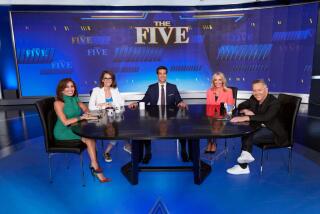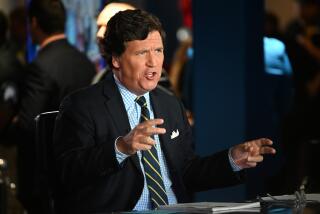Some ‘Stunning,’ ‘Dazzling’ Revelations About Cable Networks
- Share via
Rick Feldman was mad as hell, and he decided not to take it anymore.
The general manager of KCOP-TV Channel 13 in Los Angeles has grumbled for years about cable networks receiving what he deems unduly positive and excessive media attention in light of relatively low ratings.
So when Feldman saw a Daily Variety ad last week touting CNBC’s Charles Grodin talk show as “a ratings sensation,” he anted up an estimated $3,000 for another full-page ad pointing out that Grodin attracts a 0.3 rating--a mere fraction of even the lowest-rated network program. “We call it hype,” the KCOP ad concluded.
When it comes to hype, however, Grodin is hardly alone. Jenny McCarthy, co-host of MTV’s “Singled Out,” has become a magazine poster girl despite the fact that the show delivers ratings that, by network standards, would be smaller than her outfits. Ample coverage has also been showered on the launch of MSNBC, even though the new network is available in less than one out of four homes.
The issue of cable “sensations” is, in Feldman’s eyes, more than an annoyance. Letting ads touting such growth go unchallenged represents a threat to his business, he said, especially if advertisers perceive cable networks as having more reach than they do.
Overall, cable has steadily increased audience share, but much of that growth has come from new networks and regional sports channels. Many top basic-cable networks have actually seen ratings flatten out as their viewers, like those of broadcasters, are cannibalized by new services.
For that reason, cable networks often advertise any audience gains, which--given the small base from which they begin--can look significant on a percentage basis.
The Grodin ad, for example, discussed a 73% increase, but that’s off virtually nothing at the show’s outset.
Feldman largely blames print coverage of cable for accepting such adjectives as “stunning” or “dazzling” (citing trade paper accounts) to describe cable ratings.
“It’s up to the people who run these cable networks to take these lemons and make it smell like lemonade,” Feldman said. “I have a problem that there’s no critical eye placed on all this promotion.”
Broadcasters acknowledge that cable does a good job of promoting and marketing the medium. The perception that cable offers more high-quality original programming has also received a boost from the industry itself. It has bestowed an increasing number of Emmy nominations on cable, which accounted for a third of all nighttime Emmy bids issued in July.
In fact, cable executives say the medium still doesn’t get enough respect from advertisers. In Los Angeles, a $1-billion local TV market, Adlink--a venture representing more than 20 cable networks--projects cable spending at $36 million for 1996. That’s up 20% from last year but well short of basic cable’s combined audience share.
“The broadcasters are still getting the vast majority of all advertising revenue,” said Jane Piedad, Adlink’s director of research.
Feldman, however, contends that media buyers often use double standards relating to cable--shunning repeats of classic series on local TV stations but supporting them on Nick at Nite, or objecting to content in syndicated programs without balking at a show like “Singled Out.” “If we were running it, they’d spit at us,” Feldman said.
As for Grodin, the actor-turned-talk-show-host seemed genuinely perplexed at being singled out, addressing the issue on his CNBC show Monday. “I’ve been in show business . . . my whole adult life, [and] I’ve never seen anybody attack somebody else’s ad,” he joked.
For his part, Feldman insisted that the broadside wasn’t personal. “I just can’t let advertisers sit there and [accept] this,” he said.
More to Read
The biggest entertainment stories
Get our big stories about Hollywood, film, television, music, arts, culture and more right in your inbox as soon as they publish.
You may occasionally receive promotional content from the Los Angeles Times.










